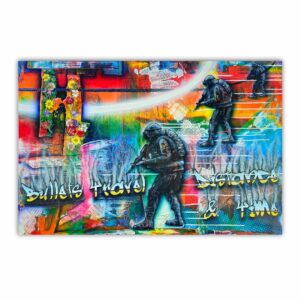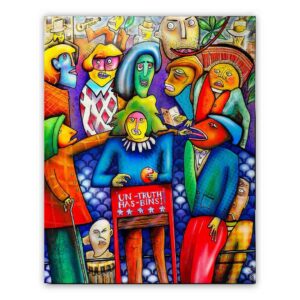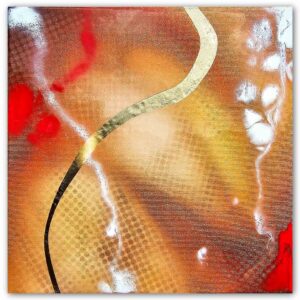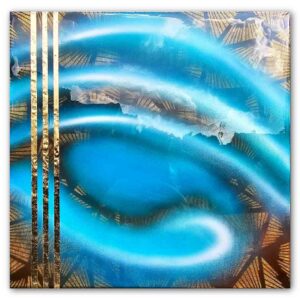- [email protected]
- +353 (0)86 224 0139
- Free Shipping Worldwide
10 Ways Cultural Identity Has Influenced Oceania Art
Oceania, a vast region encompassing the islands of the tropical Pacific Ocean, is home to a rich mosaic of cultures. The region's art is a vivid chronicle of its peoples' histories, capturing their connections to nature and spiritual beliefs.
Reading Time: 15 minutes
TL:DR
- Oceania’s art is a tapestry of cultural identities, depicting deep-rooted customs and legends passed down through generations, and frequently incorporating images from nature and the spiritual world to represent a community’s relationship to its environment and beliefs.
- The incorporation of modern materials and techniques alongside traditional traditions has resulted in shifting artistic expressions, demonstrating a dynamic balance between preserving the past and accepting contemporary influences throughout Oceanic cultures.
- Artistic exchanges and contacts, both within Oceania’s different groups and with other cultures through colonisation and globalisation, have resulted in a complex fusion that enriches Oceanic art while demonstrating resilience and adaptation in the face of change.
Introduction: Understanding Oceania Art
Oceania, a remarkably diverse region, encompasses over 20,000 Pacific islands and around 1,800 distinct cultures and languages. Oceania art refers to the artistic and religious creations by the people of Oceania and their descendants, as stated in Encyclopaedia Britannica.
The Southern Hemisphere: Where is it?
The Southern Hemisphere includes most of South America, a third of Africa, Australia, Antarctica, and certain Asian islands. The Northern and Southern Hemispheres experience different climates due to the Earth’s tilt towards or away from the sun.
The Geographic Regions of Oceania
- Australasia: This region comprises Australia, Tasmania, various smaller islands, and New Zealand. Australasia can refer to different yet interconnected areas, such as geopolitical, physiographic, and ecological. The political terms used are “Australia and New Zealand” as a unified federal republic and “South Pacific Mandate” specifically for New Zealand. The Cook Islands and Niue are typically included as well.
- Micronesia: The Federation of States of Micronesia consists of over 600 islands in the western Pacific Ocean. It encompasses four island states: Pohnpei, Kosrae, Chuuk, and Yap.
- New Caledonia: A French territory in the Pacific Ocean, New Caledonia is a long and narrow land stretching from Tahiti to New Zealand. It comprises two inhabited islands, the Grande Terre and the Loyalty Islands. The capital, Nouméa, is home to around fifty thousand people.
- Polynesia: The Polynesia sub-region spans more than 1,000 islands scattered across the southeastern and central Pacific Ocean. Polynesians are the indigenous people inhabiting these islands. They have been skilled seafarers for at least 3,000 years and are believed to have reached the Americas via the Pacific. Polynesia includes the Cook Islands, Easter Island, Hawaii, New Zealand, Samoa, Tahiti, Tonga, and Vanuatu. Many island cultures have ceremonial chiefs, known as the alii in Hawaii and with similar titles elsewhere. Despite European influence from the 17th century onwards, these islands share language, culture, and traditional beliefs.
- Melanesia: Located in the southwestern Pacific Ocean, Melanesia stretches from New Guinea in the west to Tonga in the east, including the Arafura Sea. It consists of four independent nations: Fiji, Vanuatu, the Solomon Islands, and Papua New Guinea. The languages in this region have common origins and belong to the Oceania language group.
Interesting Fact: Did you know that geographically, Hawaii is part of Oceania?
Characteristics and Meaning of Oceania Art
Oceania art showcases patterns and symbols inspired by nature. It encompasses various artistic practices like sculpture, painting, woodcarving, tattooing, pottery, weaving, ceremonial masks, and figures. Tribal art holds great significance within the region’s cultural heritage.
The traditional art of the continent draws influences from Western techniques as well as Asian and European traditions.
Oceania art carries a diverse and unique meaning. With numerous cultural identities across the continent, each region has its own distinct art form. The art of Oceanic people is a fusion of various cultural identities and traditions.
It encompasses indigenous art from the Pacific Islands, including Polynesian, Melanesian, and Micronesian cultures. Additionally, it encompasses art from Australia, New Zealand, and other countries, blending different styles and incorporating diverse traditions. Art serves as a universal language, expressing the richness of cultures.
Indigenous Oceania Art
Indigenous art in the region comprises artistic traditions passed down through generations. The term “indigenous” signifies the artists’ use of traditional materials and techniques over centuries.
Various factors, such as religion, geography, cultural values, and history, influence indigenous art. Additionally, external influences like European colonisation and globalisation impact its development.
The Indigenous people of Australia and New Zealand possess a rich culture encompassing artwork, mythology, and storytelling. Their art primarily involves rock paintings, bark paper paintings, wood and stone carvings, and sand or earth material drawings. Aboriginal artefacts hold immense cultural significance as they represent a connection to the past.
Oceania Art by Sub-Region
The art and culture of the continent can be appreciated from various perspectives, highlighting unique cultural influences and the breathtaking geography found in the region.
Australasia’s Art
The art style of the Aboriginal and Torres Strait Islander people not only holds uniqueness but also reflects their true culture and heritage. Aboriginals are believed to have settled in Australia between 60,000 and 80,000 years ago.
Aboriginal cultures follow the spiritual belief system known as animism, which views the world as alive and infused with spirits. Similar to Native American religions, animism recognises the spirit within all living beings, including animals, plants, and natural forces. This belief emphasises our equal connection to nature and the moral obligation to respect the environment around us.
Rock art provides the oldest evidence of Aboriginal philosophy, created using various ochres, which are natural earth pigments ranging from pale yellow to deeper shades of red, brown, or violet.
Aboriginal art styles differ across regions, each carrying its own unique meaning. It is the world’s oldest, unbroken tradition of art.
To depict specific stories, Aboriginal artists require permission. These stories are passed down through generations within particular ethnic groups, and the rights to paint them are inherited within families.
Aboriginal Indigenous Art Style
Aboriginal art exhibits varied character and style, depending on the region and the artist’s language. Contemporary Aboriginal art can often be attributed to the community that created it.
The use of dots in Aboriginal art is believed to conceal sacred symbols and iconography from outsiders, ensuring the protection of their sacred knowledge.
Aboriginal art encompasses more than just dots, with patterns and symbols holding different meanings for people from various parts of the country.
Dot paintings are commonly associated with the Central and Western desert regions.
In the Northern Territory, particularly in Arnhem Land, cross-hatching (Rarrk) and x-ray paintings are prevalent.
The Wandjina, also known as Gulingi, are cloud and rain spirits from Australian Aboriginal mythology depicted in rock art, originating in the Kimberley region, specifically Kulumburu.
Aboriginal Astronomy and Dreamtime Stories
Similar to Christian beliefs, Aboriginal people have their own stories explaining the origin of the world. For thousands of years, they have maintained a strong and intimate connection with the land and their surroundings.
These stories provided unity, purpose, and cultural identity to Aboriginal societies in the past and continue to be crucial in preserving their heritage.
The stories below belong to traditional Aboriginal owners and are shared with the utmost respect.
The Emu in the Sky
According to Aboriginal mythology, emus were creator spirits that flew and looked over the land. By looking south at the Southern Cross you may be able to spot an emu if you look up at the stars. The head is represented by the dark cloud between stars. Dust lanes visible comprise the neck, body, and legs across the Milky Way.
Stories of the emu in the sky have been a part of Aboriginal storytelling for thousands of years.
During the Dreaming, a blind man lived with his wife in the bush. Every day he told his wife to go out and hunt for emu eggs for him to eat. Even though his wife tried hard to please her husband, he was always angry at her, telling her that the eggs were too small.
One day while she was out hunting, she came across some very large emu tracks. She thought of her husband and how angry he got, and followed the tracks all the way to the nest. She found a huge emu there, threw stones at it to get at the eggs, but it stood up, ran towards her, and killed her.
The blind man became hungry and worried about his wife. He felt around the camp until he came across a bush with some berries on it and ate some of them. Suddenly he could see. He made some spears and a woomera and set off to find his wife. He followed her tracks and finally saw the huge emu and the body of his wife. He speared the emu and banished its spirit to the Milky Way, where it can still be seen today.
— A story from Papunya, Northern Territory.
The Canoe in Orion
A traditional Yolngu story tells how three brothers of the King-fish (Nulkal) clan went fishing, but all they could catch were king-fish. Because they were in the king-fish clan, traditional lore forbade them to eat these fish, and so they had to throw them back into the water.
Eventually, one of the brothers became so hungry that he decided to break the law, and caught and ate a king-fish.
The Sun-woman (Walu) saw this, and was so angry with him for breaking the law that she created a waterspout that lifted them right up into the sky, where you can still see them.
The three brothers are the three stars across the centre of the canoe, and the Orion nebula is the fish trailing on its line in the water. Thus, this constellation is a reminder that you had better not break the law!
— A story from the Yolngu people of the Northern Territory, known as Djulpan.
The Sun and Moon
In most Aboriginal cultures, the Sun is female while the Moon is male.
“The Sun is a lovely old lady called Walu Yolngu,”
“She gets up every morning and puts on her red ochre, which is why we get the red sunrise, lights a stringy bark tree and carries it across the sky and giving us all light and heat, travels to the west and puts out the stringy bark tree, then travels around back to camp in the east for the morning.”
In all Aboriginal cultures, the Moon is considered a bad person,
In the Yolngu story, he is called Ngalindi and he was big and round and fat like the full moon, and he was lazy.
“His wives and children got so angry because he did nothing to help, so they chopped off bits of him and he went from being a round fat moon and got thinner and thinner which is why you get phases on the Moon.
“Eventually he died and stayed dead for three nights before he came back to life, as a new moon.
“He cursed everyone and said that when he died, he would come back to life, but when others died, they would stay dead.”
— A story from the Yolngu people of the Northern Territory, known as Djulpan.
Micronesia’s Art
Micronesian art is characterised by various forms of expression, including body painting, ornamentation, singing, dancing, and the recitation of myths, tales, and poetry.
Tapuanu/Painted Mask
Masks are rare in Micronesia, primarily found in the Nomoi Islands (formerly known as the Mortlock Islands).
A typical Tapuanu/painted mask is crafted from breadfruit wood and painted with lime and black pigment obtained from soot.
These masks feature narrow eye-slits and are secured to the wearer’s head with plaited coconut fiber. They represent ancestral figures.
Traditionally, the masks were used as decorations in ceremonial and boathouses, where members of secret societies performed rituals to appease the wind god and safeguard crops from hurricanes and storms.
Polynesia’s Art: Easter Island Statues (Moai)
Polynesian art is renowned for its intricately detailed figurative designs, with the Easter Island statues, known as Moai, being the most famous symbols of Polynesian art.
The natives of Rapa Nui, the Polynesian name for Easter Island, produced the Moai of Rapa Nui, which stand about 10 feet tall and weigh approximately 14 tonnes.
The Rapa Nui people carved the Moai, which are monolithic human figures, between 1250 and 1500. They were built to represent their ancestors who had passed away, as a way to honour and commemorate them. These statues were transported from the main moai quarry, Rano Raraku, and placed on stone platforms called ahu around the island’s perimeter.
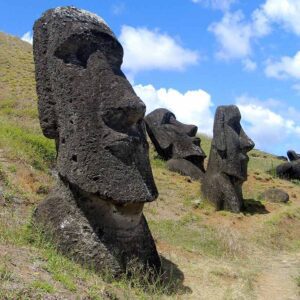
The Rapa Nui people believed that the Moai have a magical force that emanates from the statues themselves. This spiritual power was deemed to heal spiritual ailments, either for themselves or others.
The statues of Easter Island are not only impressive examples of Polynesian art, but they also remain one of the world’s greatest mysteries. The methods used to create and move these massive statues continue to puzzle researchers, with no definitive answers to these questions despite centuries of inquiry.
In addition to the Easter Island statues, the Southern Hemisphere is home to several other UNESCO World Heritage Sites. These sites include:
- Great Barrier Reef (Australia): The largest coral reef system in the world, known for its biodiversity and natural beauty.
- Machu Picchu (Peru): An ancient Incan city located high in the Andes Mountains, known for its impressive architecture and historical significance.
- Robben Island (South Africa): A former political prison where Nelson Mandela was held captive, now a symbol of the struggle against apartheid.
- Uluru-Kata Tjuta National Park (Australia): A sacred site for the Indigenous people of Australia, featuring the iconic sandstone monolith Uluru (Ayers Rock) and the Kata Tjuta (the Olgas) rock formations.
- Iguazu National Park (Argentina and Brazil): Home to the stunning Iguazu Falls, one of the world’s largest and most impressive waterfall systems.
- Historic Centre of Salvador de Bahia (Brazil): A well-preserved colonial city with a rich history and cultural heritage.
These are just a few examples of the incredible Southern Hemisphere UNESCO sites, each with its own unique significance and beauty.
Melanesia’s Art
The artwork of Melanesia is known for its striking and highly decorative nature. Many pieces depict exaggerated forms, often with a focus on sexual themes. The art is closely tied to ancestral worship, hunting, and cannibalism and is frequently used in spiritual rituals, including the creation of elaborate masks.
Fijian Mats and Tapa Cloth
The art of weaving has allowed Pacific Islander communities to create beautiful and intricate artworks. Fijian mats and tapa cloth are exceptional examples of this craftsmanship. These pieces have been passed down through generations, with knowledge and skills transmitted within families. Owning and creating these artworks allows individuals to express themselves and their cultural heritage.
The Jolika Collection of New Guinea Art
The Jolika Collection of New Guinea Art is a comprehensive compilation of artwork gathered over four decades by New York philanthropists John and Marcia Friede. This collection is promised to the de Young Museum in San Francisco for public display.
Comprised of thousands of objects, the collection represents hundreds of clans and villages throughout New Guinea. It includes beautifully crafted masks, shields, headdresses, ceremonial items, and personal objects. Considered one of the world’s finest compilations of Papua New Guinea art, it offers valuable insight into the region’s diverse artistic traditions.
Sepik Art in Papua New Guinea
Sepik sculptures are renowned for their diverse range of styles, making them one of the most varied art groups worldwide. The Sepik region, despite its small geographic area, is culturally rich, with numerous language groups and distinct art styles.
Development of the Oceania Art Market in the West
In the late 18th century, as explorers, traders, and missionaries returned to Europe, bringing back ethnographic artefacts, the market for Oceania art began to take shape. Ethnography refers to the systematic study of individual cultures within anthropology.
These artefacts were initially viewed as curiosities and found their way into collections and displays across Europe, both in museums and private collections.
As time passed, Oceania’s art gained recognition in the Western world, especially in the southern hemisphere countries. Its influence on contemporary artists became significant during the twentieth century.
Art dealers and avant-garde artists, such as Matisse, Picasso, and André Derain, began collecting ethnographic objects. This influence led to the art movement known as Primitivism.
Famous Oceania Artists
The continent boasts painters, tattooists, poets, and storytellers. Their various styles unite them through heritage.
One of the books I have in my modest art book collection is a copy of ‘Tribal Tattoo Design’ by Maarten Hesselt Van Dinter. Even though I do not have any tattoos, I was immediately drawn to it when I first saw it at the Elliott Bay Book Company when I was living in Seattle.
Tattoo artists will find this book invaluable. It features abundant designs from tribes with undeniable strength and authenticity, which reflect the cultural symbolism in Oceania art.
Cultural identity is integral to society and infused in artwork. In this section we explore artists who stand out and celebrate their customs.
Famous Australian Aboriginal Painters
Albert Namatjira (born Elea Namatjira; 28 July 1902 – 8 August 1959) was an Arrernte watercolour landscape artist from Central Australia.
Namatjira is widely considered one of the greatest Aboriginal watercolour painters. Australian audiences embraced him with popularity.
His colourful watercolour paintings depicted the Australian desert landscape, diverging from traditional ochre or dot-style artworks.
The Arrernte share everything they own. As Namatjira’s income grew, he supported over 600 people. Despite his fame, he lived in poverty.
Due to land dealings and other unfortunate decisions, he sought Australian citizenship. Remaining Aboriginal, he gained voting rights, land ownership, and more.
At his death, Namatjira had created over two thousand works. He is a pioneer in Aboriginal rights and one of Australia’s finest artists.
Australian Artists
Driven by a love for the country’s natural environment, Australian artists create stunning artwork. Indigenous culture often influences their perspectives.
Australia, the world’s sixth-largest country, boasts a vibrant and diverse art scene. Artists here embrace diversity, making it a great place to be a fan of art.
Their deep connection to nature inspires Australian artists. Indigenous culture shapes their artwork, reflecting personal lives and influences.
Mark Waller’s work showcases nature’s beauty and the wonders of the universe. I discovered him through an online search and his assistant, Frankie.
Mark experienced a profound spiritual awakening, following the discovery of brain and lung cancer. Faced with death, he was surprised to discover that it was possible to experience joy and light. He has written about his experiences in hospital and on chemotherapy wards, these accounts are in fact profound celebrations of life despite the seriousness of his situation.
I urge you to explore his work and unique perspective.
Samoan Artists
Mary Jewett Pritchard, an American Samoan textile artist, revived siapo and tapa crafts.
Su’a Sulu’ape Paulo II, born in Samoa, was a master tattoo artist. He followed a guild-like system of masters and apprentices.
During the late 20th and early 21st centuries, tufuga ta tatau were known for their culturally distinct and highly skilled work. The word ‘tattoo’ may come from ‘tatau‘.
Samoan mythology credits Tilafaiga and Taema with introducing tattooing. Samoan male tattoos are called pe’a, while female tattoos are called malu.
Momoe Malietoa Von Reiche is a Samoan poet, artist, sculptor, and photographer.
Characteristics of Oceania Architecture
Oceania’s architecture varies based on geographical and physical conditions. Buildings are designed to adapt to the ever-changing environment. In tropical islands, thatched roofs, walls, and raised floors are used to withstand heavy rain and humidity. Islands with temperate climates employ monolithic stone construction.
By the 16th century, architecture in the region had reached a settled state and remained conservative for centuries. Contact with Europeans in the 18th century sparked change, incorporating fake antiquities and blending traditional forms with European trends.
The iconic ‘fale’ is a cone-shaped building with a thatched palm frond roof and a clay or coral-slab floor. The traditional Samoan house, known as “fale tele,” is raised on posts with a platform. It serves as a meetinghouse or guesthouse.
World War II caused significant damage to the islands and transformed traditional ways of life with the introduction of modern technology and western culture. Reconstruction was slow due to the absence of war reparations and the destruction of plantations.
Solomon Islanders, having worked with the Allies, recognised the importance of economic organisation and trade for progress. After the war, the ‘Maasina Ruru‘ movement aimed for independence, emphasising the rule of ‘relationship of siblings together.’ This is often mistranslated to ‘Marching Rule’, ‘Marxist Rule’, or ‘Rule of Brotherhood’.
Obviously, the sun’s orientation differs in the northern and southern hemispheres! In the north. In the Northern Hemisphere, windows are preferred in southward direction to maximise sun exposure. Whereas, in the Southern Hemisphere, homes are best placed pointing northward to benefit from passive or active solar heating.
Interestingly, water drains clockwise in sinks in the Northern Hemisphere, counter-clockwise in the Southern Hemisphere, and straight down on the equator.
Characteristics of Oceanic Dance and Music
Oceania, a vast region of the Pacific Ocean, encompasses diverse islands and countries like Australia, New Zealand, and the Pacific Island nations of Polynesia, Micronesia, and Melanesia. When exploring Oceanic dance, it is important to acknowledge the cultural diversity across these islands, which is reflected in their unique dance forms.
Oceanic dance exhibits various characteristics influenced by each culture. Dance is often closely tied to social functions, including religious ceremonies, coming-of-age rituals, weddings, and community events. Many Oceanic dances are rooted in storytelling, using movement to convey myths, historical events, and daily life experiences.
Movements in Oceanic dance are purposeful and meaningful. In Polynesian dances like the Hawaiian hula or Tahitian ‘Ori, hand gestures may represent elements of nature, such as swaying trees or flowing water. Dances can be graceful with fluid motions and subtle gestures, or they can be dynamic and energetic, involving vigorous hip movements, stomping, and clapping. Costumes and body adornments play a significant role, visually enhancing the storytelling and often reflecting the local environment through the use of flowers, leaves, feathers, and shells.
Traditional instruments, such as drums, flutes, and conch shells, play an important role in Oceanic dancing music. The rhythm sets the pace and intensity of the dance, sometimes tightly synchronised with the dancers’ movements. Vocalisations, including chants or songs, often accompany dance performances, adding another layer of narrative to the dance.
Oceanic dances are community-oriented, encouraging group participation and emphasising the connection to ancestral traditions. It is not limited to trained dancers alone; in some cases, the entire community takes part in the performance, signifying the importance of dance in preserving social bonds and cultural heritage.
Appreciating these characteristics requires understanding the unique cultural contexts within Oceania. Each island’s dance forms are distinct, deeply rooted in their traditions, and contribute to their individual identities.
Characteristics of Oceania Music
Oceania music is known for its ethereal and otherworldly sound. It often incorporates complex rhythms and melodies, aiming to convey the beauty and power of the ocean.
The music of Oceania encompasses Polynesia, Micronesia, and parts of Melanesia. String instruments like the guitar, ukulele, surf guitar, and slit drum are commonly used. Melody holds significant importance in Oceanic music.
Polynesian music is well-known for pop and rock songs with English lyrics, while Micronesian music encompasses various styles, including reggae. Traditional Polynesian music is often notated, distinguishing it from traditional music in other regions.
Oceanic music refers to music originating from Pacific Islanders, including Polynesians, Māori, and Hawaiians. The term can also encompass music from other regions and peoples with origins in Oceania, such as Micronesia, Melanesia, and Australia. The rhythm in Oceanic music is characterised by a strong, steady, and regular pulse, giving the sounds of the region’s musical instruments a distinct quality.
Australian Music
Australian indigenous music reflects the music of Aboriginal and Torres Strait Islander people. It has intertwined with their cultural and ceremonial observances throughout history. Since European colonisation in the 18th century, indigenous Australians have combined Western musical styles with traditional instruments.
Traditional Australian instruments include the didgeridoo, clapsticks, gum leaf, bullroarer, and rasp. Non-Indigenous artists have also incorporated and sampled Indigenous Australian sounds and instruments in their own works. Many Indigenous Australian artists have ventured into contemporary genres such as rock and roll, country, rap, hip-hop, and reggae.
Micronesian Music
The music of Micronesia is a diverse blend of traditional and modern styles, influenced by Polynesia, the Philippines, Japan, and the United States. It is typically percussion-based, featuring a strong rhythm section and instruments like the jaw harp and bamboo flute.
Polynesian Music
Polynesian music combines vocal and instrumental elements, often incorporating drums, rattles, and flutes. Unique instruments such as the ukulele, steel guitar, and conch shell are commonly used in Polynesian music.
Melanesian Music
Melanesian music is characterised by the use of percussion instruments like drums and clapping sticks, as well as single-stringed instruments like the fiddle or ukulele. It encompasses a mix of traditional and modern styles, with vocals and percussion playing prominent roles.
Characteristics of Oceanic Food and Drink
Oceania, encompassing diverse cultures and climates, showcases a wide range of food and drink traditions. With Australia, New Zealand, Polynesia, Micronesia, and Melanesia making up the region, each area has unique culinary practices influenced by indigenous cultures, local ingredients, and historical factors like colonialism and immigration.
Australian cuisine, influenced by British colonisation and later waves of immigrants, incorporates flavours from Mediterranean and Asian cuisine. Staple foods include beef, lamb, and seafood, as well as indigenous ingredients like kangaroo, emu, and bush tucker such as wattleseed and finger limes. The communal aspect of meal preparation is highlighted through the traditional method of cooking known as the “barbie” or barbecue.
Maori culture greatly influences New Zealand cuisine, which has British roots as well. The Maori hangi, a traditional cooking method using heated rocks buried in a pit oven, holds significance. Dairy products, lamb, and seafood from the rich marine environment are prominent in New Zealand’s food.
The terrain of the Pacific Islands influences its foodways, which emphasise seafood, root vegetables such as taro and sweet potatoes, and tropical fruits like coconut, papaya, and guava.
Traditional cooking methods often involve earth ovens, or umu/pimu, and emphasise communal aspects. Fermented beverages derived from crops like coconuts are also common.
Micronesia and Melanesia utilise the abundant ocean resources and tropical vegetation, with staples like fish, taro, breadfruit, and yam featuring prominently. Unique cooking techniques involving wrapping food in leaves and cooking over hot stones or in earth ovens are employed.
Characteristics of Oceanic food and drink include:
- Use of local, often unique, ingredients, including seafood, tropical fruits, and root crops.
- Communal cooking and eating are integral cultural practices.
- Traditional cooking methods such as earth ovens and barbecuing.
- Influences from other culinary traditions due to historical migrations and colonisation.
- Emphasis on indigenous methods and ingredients, particularly in remote areas and smaller islands.
Drinks across the region include not only fermented beverages but also beer, wine, and coffee. Australia and New Zealand are significant producers of high-quality wine, while both countries have also contributed to coffee culture innovations.
How can I overlook the many excellent southern hemisphere wines from the region? There is no shortage of delicious wines to choose from, thanks to the popularity of New Zealand Sauvignon Blanc and Australian Shiraz.
These characteristics highlight the rich diversity and cultural significance of food and drink in Oceania.
Characteristics of Oceania Dress and Clothing
The traditional dress of many Oceanic cultures is often the most visible part of their culture. Geographical, climate, cultural, and historical variables all have an impact on Oceania’s traditional attire and clothing designs. The diversity of islands and peoples in the region has shaped distinctive clothing traditions across different cultures.
One common characteristic of traditional Oceanic dress is the use of natural materials. Leaves, grasses, tree bark, and fibres from plants like hibiscus and coconut feature prominently in clothing. Tapa cloth, created by crushing the bark of specific trees into thin sheets, is a favored fabric for clothing in Polynesia and Melanesia.
Due to the warm and humid climate in many parts of Oceania, traditional clothing tends to be minimal. Loincloths, sarongs (lava-lavas), and grass skirts were commonly worn, and in some cultures, going topless was a traditional practice. However, Western clothing made with its synthetic materials has become more prevalent in modern times, although traditional attire is still worn during cultural events, ceremonies, and official functions.
Adornments and accessories play a significant role in traditional Oceanic dress. Necklaces made of shells, feathers, teeth, or bone are commonly worn, adding aesthetic appeal and carrying symbolic meanings. Body art, such as tattoos and face painting, is also important in Oceanic cultures, representing social status, community affiliations, and rites of passage.
The characteristics of dress and clothing vary across the diverse cultures of Oceania. In Polynesia, the Hawaiian aloha shirt and the Samoan puletasi (a matching skirt and tunic set) are distinctive traditional garments. In Melanesia, notable examples include the bilum bag from Papua New Guinea and the penis gourd, or koteka, worn in parts of West Papua and Papua.
Additionally, for example, Māori’s ate a lot of seafood and plants that grew on the ground. Their clothing was made out of plant fibre and was a lot looser than is seen in other cultures. Their culture and art reflect the way their society was completely based around the sea.
Overall, Oceania’s dress and clothing traditions are complex and varied, with each island nation and culture having its own unique traditions. However, the use of natural materials and adaptations to the climate are common themes seen throughout the region.
Characteristics of Oceania Cinema
Oceania cinema stems from the distinct geography, culture, and history of the Pacific Islands region. Historically, Australia and New Zealand’s film industries outshine the smaller Pacific Islands. They reflect Western film traditions due to colonial histories and European influence.
The film industry in the region is thriving and is responsible for some of the most popular movies around the world. For example, New Zealand’s generous tax breaks for The Lord of the Rings and The Hobbit trilogies (2001-2003 and 2012-2014, respectively) and The World’s Fastest Indian (2005) have resulted in these films being produced.
New Zealand has become a major hotspot for film productions and in turn has helped tourism. The country offers beautiful scenery with wide variety of locations, as well as the competitive benefits, which means productions can be made at a much lower cost.
In contrast, the smaller Pacific Islands’ cinema draws heavily from indigenous cultures and storytelling. It prioritises community involvement and local narratives, blending oral traditions, performance arts, local languages, and cinematic techniques. This unique approach showcases cultural authenticity and innovative execution.
A recurring theme in Oceanian cinema, especially in Pacific Island nations, is the exploration of post-colonial identity, power dynamics, and the clash between tradition and modernity. The deep cultural ties indigenous groups have with their environment, particularly land and sea, are also prominently portrayed.
It’s worth noting that, due to limited resources and smaller economies, films from smaller island nations often work with low budgets and non-professional actors, relying on community support. Despite constraints, this fosters creativity and imbues storytelling with a sense of intimacy and authenticity.
Moreover, Oceania cinema has gained international recognition, featuring in festivals dedicated to indigenous and underrepresented cinemas as well as broader international film festivals. This exposure promotes a nuanced understanding of Oceanic cultures and narratives, challenging dominant Western cinematic perspectives.
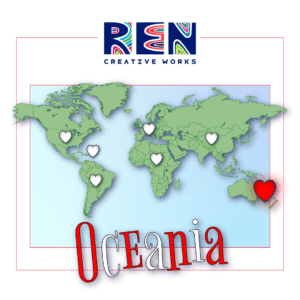
Conclusion: A Diverse Continent of Islands
I hope you enjoyed this blog post on the ways in which cultural identity has influenced Oceania art. The continents art is a popular form of artwork that is widely studied and appreciated by many people.
As an art form, it has roots that can be traced to the spiritual beliefs of the indigenous peoples of the Pacific Islands and Australia. Oceania art can be identified by its unique designs and patterns which are often based on animals, flowers and plants.
The body of artistic and religious work created by the inhabitants of Oceania, or their descendants, is diverse, with different form and subject matter. There is also a diversity in style, and the media on which it is created, that makes it so intriguing with its uniquely different perspectives.
Art education has a significant impact on our comprehension of it. It is very common for people to ignore masterpieces within reach of them if they do not know where to look or how to appreciate them. By changing this concept, I seek to encourage a wider interest in all forms of art.
Taking the time to become acquainted with various cultures and their beautiful works of art while remaining aware of one’s own identity is crucial.
Perhaps some of these insights might even help you in your future art endeavours. If you would like to learn more about how cultural identity affects other regions of the world, you should check out the main article on this topic, and other regions of the world by clicking on the links below:
- 10 ways cultural identity has influenced African Art
- 10 ways cultural identity has influenced Asian Art
- 10 ways cultural identity has influenced Caribbean Art
- 10 ways cultural identity has influenced European Art
- 10 ways cultural identity has influenced North America’s Art
- 10 ways cultural identity has influenced South America’s Art
- Famous Irish Art and Cultural Identity
If you enjoyed this article, please show your support by subscribing to my mailing list and sharing it with your network! As an independent artist, your support means the world to me. Your time is valuable, and I appreciate you taking the time to read my blog.
Don’t miss out on future articles and updates – subscribe now and stay connected!
`Tribal Tattoo Design by Maarten Hesselt Van Dinter`
Publisher: The Pepin Press (January 1 2000)
Language: English
Paperback: 360 pages ISBN-10: 9054960736
Adrian Reynolds, or ‘Ren,’ is a Dublin-based contemporary artist. His works are a reaction to the world around us. A world that continues to evolve quicker than ever. His work investigates colour, form, and texture, putting them at the intersection of abstraction and representation. His art has been shown in Ireland, the United Kingdom, and the United States.
Latest Artwork
-
Bullets Travel Distance & Time
Abstract Art Paintings €1,000.00Add to basketBullets Travel Distance & Time | Acrylic Painting By Adrian Reynolds
-
The Perception of Narrative
Abstract Art Paintings €800.00Add to basketThe Perception of Narrative | Fine Art Acrylic Painting By Adrian Reynolds
-
Iridescent Dream
Abstract Art Paintings €240.00Add to basketIridescent Dream | Acrylic Painting By Adrian Reynolds
-
Blue Nebula
Abstract Art Paintings €240.00Add to basketBlue Nebula | Acrylic Painting By Adrian Reynolds
